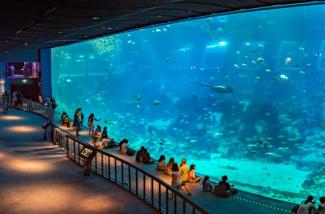
Singapore, 29 November 2017 (Wednesday) – The Institute of Service Excellence (ISE) at Singapore Management University today released the 2017 third quarter (Q3) Customer Satisfaction Index of Singapore (CSISG) results for the Food & Beverage (F&B) and Tourism sectors. Both sectors registered statistically significant increases in customer satisfaction scores compared to Q3 2016. The Tourism sector scored 74.2 points (+3.14 points/ +4.4% year-on-year) while the F&B sector scored 71.7 points (+1.68 points/ +2.4% year-on-year).
F&B Sector Highlights
The F&B sector is made up of four sub-sectors including Snack Bars & Food Kiosks*, Cafes & Coffee Houses*, Fast Food Restaurants, and Restaurants. While customer satisfaction remained statistically unchanged year-on-year for the Fast Food Restaurants sub-sector at 71.7 points (+0.92 points/+1.3% year-on-year), a statistically significant year-on-year increase was seen in the Restaurants sub-sector which scored 71.5 points (+1.76 points/+2.5% year-on-year).
Locals More Satisfied With Restaurants
The increased satisfaction for the Restaurants sub-sector was driven predominantly by higher satisfaction among locals. Locals reported higher scores for drivers of satisfaction such as Perceived Overall Quality and Perceived Value whilst scores for tourists remained statistically unchanged across these dimensions.
Locals also gave statistically higher satisfaction ratings for attributes such as ‘ease of making reservations’, ‘menu options to suit your needs’, and ‘quality of food’.
Longer Waiting Times Associated With Lower Satisfaction And Loyalty
Within the Fast Food Restaurants and Cafes & Coffee Houses sub-sectors, customer satisfaction and loyalty scores were lower among respondents who indicated a wait time of more than 10 minutes to queue and receive their order. There was a similar finding observed among Restaurants respondents who waited more than 20 minutes to receive their food.
“Given that the issue of waiting time was found to be a common driver of both perceived overall quality and loyalty, F&B operators would do well to bear this in mind when designing their service processes,” said Mr Chen Yongchang, Head of Research and Consulting at ISE.
Tourism Sector Highlights
Within the Tourism sector, the Hotels and Attractions sub-sectors were measured. Compared to the same period last year, the Hotels sub-sector registered a statistically significant increase in customer satisfaction score, achieving a score of 74.4 points (+1.88 points/ +2.6% year-on-year) this year. The increase was driven predominantly by higher Perceived Service and Product Quality. As for the Attractions sub-sector, it achieved a score of 73.3 points (+0.43 points/+0.6% year-on-year). The sub-sector however did not see any statistically significant year-on-year movement in its score.
Service A Key Driver of Perceived Quality For Luxury and Upscale Hotels
Comparing between Luxury and Upscale Hotels and Economy Hotels, it was apparent that for Economy Hotels, product-related attributes such as ‘ambience of the room’ and ‘comfort of the room’ had a larger impact in driving up Perceived Overall Quality than service-related attributes.
On the other hand, for Luxury and Upscale Hotels, while product-related attributes were important drivers of Perceived Overall Quality, service-related attributes such as ‘ability of the hotel to accommodate to your needs or requests’, and ‘efficiency of the check-in process’ also emerged as key drivers of perceived quality.
“While customers expect hotels to do well in ensuring comfortable rooms, excellent service and having well-designed processes remain as key differentiators in the hotel industry. This is especially so for luxury and upscale hotels,” said Ms Neeta Lachmandas, Executive Director of ISE.
Locals More Satisfied With Attractions, Especially Among Those Accompanied By Their Families
While the overall Attractions sub-sector did not see any statistically significant movement in satisfaction, locals were more satisfied this year than in 2016. In particular, locals rated attributes such as ‘entertainment and/or educational value of the attraction’, ‘cleanliness of the attraction’ and ‘friendliness and courtesy of the staff’ statistically higher. In addition, locals who visited the attraction with their families were found to have statistically higher loyalty scores as compared to locals who either went alone or with other companions.
“When considering local customers, Attractions may wish to consider targeting this segment given that this was the largest segment among locals, and the most loyal,” Mr Chen added.
The CSISG 2017 Q3 study was conducted between July and October 2017. A total of 6,900 respondents comprising 3,035 locals and 3,865 tourists were surveyed. Please refer to Annex A for a background on the CSISG and Annex B for the detailed scores.
*Snack Bars & Food Kiosks and Cafes & Coffee Houses are newly constituted sub-sectors. Prior to 2017, ‘Cafes & Coffee Houses’ and ‘Snack Bars & Food Kiosks’ were measured as one sub-sector ‘Cafes & Snack Bars’. Therefore, there is no basis for year-on-year comparisons.
In addition, the following sectors were removed from CSISG measurement in 2017: Bars & Pubs, Food Courts, Travel & Tour Services, and Online Travel Agencies.
For media queries, please contact:
Ms Serene Ashley Chen
Assistant Director, Partnerships and Programme Development
Institute of Service Excellence (ISE) at Singapore Management University
DID: (65) 6808 5103
Mobile: (65) 9151 9030
Email: serenechen [at] smu.edu.sg (serenechen[at]smu[dot]edu[dot]sg)
Mr Teo Chang Ching
Senior Assistant Director, Corporate Communications
Office of Corporate Communications and Marketing
DID: (65) 6828 0451
Mobile: (65) 9431 8353
Email: ccteo [at] smu.edu.sg